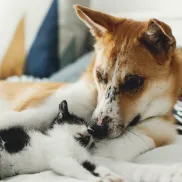Signs your pet is dehydrated — and simple steps to prevent it
Most of us recall our mothers telling us to drink more water. But getting enough water is just as important for pets, whose bodies are made up of 80% water — compared to 60% for us humans.
Importance of proper hydration
Staying properly hydrated is critical to your dog or cat’s health. Check out some of the great benefits your pets will enjoy just by staying hydrated:
- Pets who stay hydrated have lower risk of urinary tract infections. They also may avoid developing urinary stones or crystals that can cause obstructions.
- Water has a cooling effect on a pet’s body and helps it maintain a consistent temperature, even in hot weather.
- Water helps animals convert fat to energy. That means enough energy for play and exercise.
- Being properly hydrated promotes easier healing and recovery. Drinking water keeps your pets’ kidneys healthy and flushes toxins from their bodies.
Know the signs of dehydration
So now that we know why it’s important, check out some of the signs that your four-legged friend is in need of some H20:
- Vomiting and/or diarrhea
- Loss of energy
- Excessive, ongoing panting
- Loss of appetite
- Sunken, dry eyes
- Dry, sticky gums
- Loss of skin elasticity
If you think your pet is dehydrated, call your vet immediately for advice. Your vet can monitor your pet’s condition and administer fluids if necessary.
Five tips to help your dog or cat stay hydrated
- Know how much water your pet needs
Pets need one ounce of water for each pound of body weight. So, a 10-pound cat needs to drink 10 ounces of water every day. A 70-pound Labrador needs 70 ounces of water daily.
It can be hard to keep track of what your pet drinks during the day, but knowing how much it needs will help you keep a closer eye on its water intake.
- Make sure your pet has fresh water at all times
Always make sure your pet has access to fresh water. If your pet must be left alone, be sure it can reach its water dish and that the dish can’t be tipped over. Be sure to change your pet’s water frequently and wash the bowls every day to prevent bacteria from growing.
And, when you’re on the go with your pet, don’t forget to bring water. If you’re thirsty, it’s likely your pet is, too.
- Provide a place to cool off
Pets heat up quickly in the sun, especially those with dark coats. If your pet spends time outdoors, always be sure it has a spot to escape the sun and cool off.
- Add water to your pet’s food
Dry kibble isn’t high in water content. If you’re worried your pet isn’t getting enough water, add a little water to its dry food or offer more wet food.
- Try a pet drinking fountain
Pets are instinctively drawn to running water. That’s why so many pets will drink more from a fountain than from a traditional water dish.
Here’s to a healthier, happier, hydrated pet!
Get one step closer to protecting your pet.
or call us at











